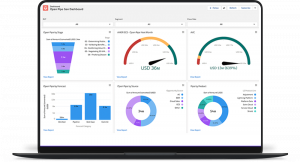Before investing in large companies, it can be helpful to identify the factors that move the stock prices for the bigger guys so that you can invest with confidence (and the ability to know what you’re looking at when you read the charts).
Stock prices fluctuate daily, especially for large corporations like mining giant BHP – just take a look at the BHP share price chart. Understanding the reasons behind fluctuations in stock prices can aid you in identifying strong, long-term performers and investing wisely.
Ultimately, many variables influence stock prices which means they’re not always easy to predict, but here we have lined out some of the common factors that move stock prices.
Earnings reports
During earnings season, stock prices often dance to the tune set by companies’ financial disclosures. Exceeding profit expectations creates stock price surges while missing the mark results in plunges.
For prominent corporations, earnings announcements hold influence over valuations. Reports that create long-term profit confidence through metrics demonstrating operational efficiency lift stock valuations.
Conversely, financial disclosures that reveal weaknesses or cast uncertainty over future profit trajectories tend to sink share prices through investor sell-offs, so keep a keen eye on your portfolio throughout earnings season.
Market sentiment
Stocks do not trade in isolations but rather react to overarching risk appetite trends. As economic policy shifts, geopolitical tensions evolve and business cycle outlooks fluctuate, associated fear or optimism circulates among investors. This broad sentiment serves to lift or drop valuations across sectors.
Recession concerns may favour enterprise technology stocks with assumptions of steadier investment capacity while rising rate fears sink apparel retailers due to discretionary spending pullback worries despite unchanged financials.
Sentiment often becomes a self-fulfilling prophecy as shifting capital flows bend reality towards investor perceptions, so these are important to understand – even the misconceptions.
Industry trends and competitive landscape
Disruptive technological breakthroughs and evolving consumer behaviors constantly reshape sector dynamics, determining who swims and who sinks.
For example, once dominant Big Oil is facing pressure throughout the accelerating energy transition while previously written-off automakers like Ford and GM have seen renewed interest in electric vehicle ambitions.
The trends provide strong tailwinds for strong leaders while disrupting the bigger corporations still clinging to outdated business models.
Identifying and capitalising on the next big shifts early allows corporations to ride waves to new heights instead of drowning in disruption. Ultimately, industry momentum makes or breaks long-term winners and influences share price.
Macroeconomic factors
Key indicators like unemployment, GDP growth, price stability and interest rates serve as the economy’s vital signs, diagnosing overall health and setting monetary policy.
A falling housing market shrinks demand for raw materials from mining giants to appliance makers, while expansion feeds appetites down multiple supply chains.
Factors like loose central bank policies promote risk-on behavior, sending valuations soaring across higher growth plays like cloud software stocks while fears of runaway inflation and rate spikes pull capital towards traditional hedges like consumer staples.
Ultimately, the macro climate directly impacts investor choice and business prognosis even with company sheets unchanged.
Regulatory changes
Policy overhauls like sweeping climate legislation and tighter industry oversight introduce new barriers that threaten profits for big companies. As regulatory regimes experience upheaval after extended periods of stability, uncertainty strikes.
Corporations and shareholders can grow wary over potential margin decreases from fines and restrictions. However, planned transitions also allow companies to adapt through early capital reallocation while creating openings for new entrants less exposed to shifting rules.
Policy therefore cuts both ways – but ignoring seismic shifts courts disaster.
Investor expectations
Markets ultimately represent predictions on corporate futures, with shares trading on those forward assumptions over intrinsic worth.
Positive analyst recommendations, transformational innovation rumors or restructuring hopes lift stock prices independent of current revenues as imagined potential gets priced in.
High multiples embed growth expectations that leave minimal room for error while low earnings valuations bake in pessimism that limits downside.
Detachment from underlying fundamentals introduces additional volatility but also allows visionary leaders anticipating the next curve to claim outsized gains.
Final thoughts
In essence, stocks sit at the intersection of earnings reports, market psychology and structural undercurrents – balancing concrete numbers against fickle sentiment and long-term shifts.
While perfectly timing daily swings remains hopeless, tracking these indicators offers a fighting chance at spotting turns ahead of the crowd, hopefully bringing you investment success in the long term.





